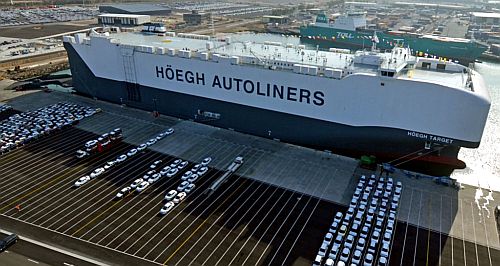Make / Model Search
News - General News - EmissionsImport-only car market grows CO2 emissionsAustralia’s reliance on imported vehicles adds a lot to our overall carbon footprint20 Jan 2025 By MATT BROGAN AS AUSTRALIA prepares to embrace the New Vehicle Efficiency Standard (NVES) – and the associated benefits cleaner and greener vehicles will bring – it is worth considering the impact globalised production and shipping plays in the overall carbon footprint of the vehicles we purchase.
Without localised vehicle production, new vehicles sold here are mostly shipped using roll-on/roll-off (RoRo) car carriers, the largest of which can transport up to 6600 cars at a time.
Others are transported in shipping containers and, in some cases, exotic vehicles are air-freighted.
It is also worth remembering that most vehicles are trucked to port, and then from the port to local dealerships, adding further to the emissions produced even before the first customer fires up its engine or energises its electric drivetrain.
But excusing that portion of the journey, and the massive volume of emissions created in producing a vehicle in the first instance, it is the shipping of vehicles all over the world that is overlooked in policies like the NVES – and largely by those purchasing a “more efficient new car”.
Last year (2024), Australia imported and sold some 1,220,607 vehicles from as far away as the United States and Europe. Many of these vehicles were transported by road or rail before reaching their departure port, and all by road or rail at the receiving end.
Based upon an average capacity of 6000 vehicles per ship, that equates to some 236.3 vehicle shipping movements into Australia over the past 12 months. And of course, all these ships made a return journey to their home port, likely for another load of cars.
Research conducted by GoAuto found that on average, a RoRo car carrier consumes an average of 16 tons (45,305.6 litres) of fuel oil per hour while emitting 60 grams per cargo tonne per kilometre.
Multiply that by an assumed cargo of 6000 vehicles per movement – and at an average weight of 1600kg per vehicle – and that is 576,000 grams of CO2 emitted per kilometre travelled.
Now, given the average emissions intensity for all vehicles on Australian roads as of January 2024 is 193.7g/km – and with Australians travelling an average of 12,100km per year – our total CO2 output per vehicle is 234.4 tonnes annually.
Given there are an estimated 19,768,518 vehicles on Australian roads, that is a conservative CO2 emissions output of 463.9 million tonnes per annum.
Weighing that up against the annual CO2 produced by the ships that bring our new cars to port each year, with 236.6 shipping movements to Australia travelling a one-way total of 3,330,816km over 7152 days at sea – and with fuel use of 2831.6 litres per hour, our overall CO2 emissions total for 2024 comes to 1,918,550 tonnes.
Considering each ship makes a return journey, we can assume a doubling of that figure to 3,837,100 tonnes of CO2 from vehicle imports to Australia each year given the number of vehicles exported from this country is negligible.
The impact of global shipping also applies to the majority of fuel used in Australia, given most of it is imported, so fuel use and an ageing vehicle fleet play a large role in Australia's domestic emissions footprint and urban air quality, making it is understandable why the federal government was so keen to push through NVES legislation.
However, it is vital that similar efforts are made in reducing those emissions produced by the shipping fleet Australia’s new-vehicle market is so heavily dependent upon.
The good news is that RoRo vessels and other ocean cargo carriers are increasingly switching to dual fuel systems that burn liquid natural gas (LNG) and low-sulphur fuel oil to reduce emissions by a claimed 30 per cent.  |
Click to shareGeneral News articlesResearch General News Motor industry news |









Facebook Twitter Instagram